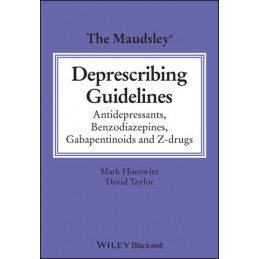- Obniżka


 Dostawa
Dostawa
Wybierz Paczkomat Inpost, Orlen Paczkę, DHL, DPD, Pocztę, email (dla ebooków). Kliknij po więcej
 Płatność
Płatność
Zapłać szybkim przelewem, kartą płatniczą lub za pobraniem. Kliknij po więcej szczegółów
 Zwroty
Zwroty
Jeżeli jesteś konsumentem możesz zwrócić towar w ciągu 14 dni*. Kliknij po więcej szczegółów
Comprehensive resource describing guidelines for safely reducing or stopping (deprescribing) antidepressants, benzodiazepines, gabapentinoids and z-drugs for patients, including step-by-step guidance for all commonly used medications, covering common pitfalls, troubleshooting, supportive strategies, and more.
Most formal guidance on psychiatric medication relates to starting or switching medications with minimal guidance on deprescribing medication. In 2023, the World Health Organisation and the United Nations called for patients, as a human right, to be informed of their right to discontinue treatment and to receive support to do so.
The Maudsley Deprescribing Guidelines fills a significant gap in guidance for clinicians by providing comprehensive and authoritative information on this important aspect of treatment.
This evidence-based handbook provides an overview of principles to be used in deprescribing. This is derived from fundamental scientific principles and the latest research on this topic, combined with emerging insights from clinical practice (including from patient experts).
Building on the recognised brand of The Maudsley Prescribing Guidelines, and the prominence of the authors’ work, including in The Lancet Psychiatry on tapering antidepressants (the most read article across all Lancet titles when it was released). The Maudsley Deprescribing Guidelines covers topics such as::
Written for anyone interested in safe deprescribing of psychiatric medications including psychiatrists, GPs, pharmacists, nurses, medical trainees, and interested members of the public. The Maudsley Deprescribing Guidelines is an essential resource on the subject that provides practical guidance on how to improve patient outcomes in this field of medicine.
Opis
Preface ix
Acknowledgements xii
Notes on Using the Maudsley® Deprescribing Guidelines xiii
Abbreviations List xv
Chapter 1 Introduction to Deprescribing Psychiatric Medications 1
Deprescribing as an Intervention 1
The context for deprescribing 2
Why deprescribe? 7
Barriers and facilitators to deprescribing 11
Withdrawal Effects from Psychiatric Medications 13
Mis-diagnosis of withdrawal effects as relapse 13
Pathophysiology of psychiatric drug withdrawal symptoms 16
Clinical aspects of psychiatric drug withdrawal 19
Specific issues in psychiatric drug withdrawal 23
How to Deprescribe Psychiatric Medications Safely 27
The neurobiology of tapering 28
Practical options for prescribing gradually tapering doses 36
Psychological aspects of tapering 43
Tapering psychiatric drugs in practice 45
Further topics 52
Chapter 2 Safe Deprescribing of Antidepressants 57
When and Why to Stop Antidepressants 57
Adverse effects of antidepressants 66
Discussing deprescribing antidepressants with patients 72
Withdrawal Effects from Antidepressants 76
Recent developments in the understanding of antidepressant withdrawal 76
Pathophysiology of antidepressant withdrawal symptoms 80
Clinical aspects of antidepressant withdrawal 87
How common, severe and long- lasting are withdrawal symptoms from antidepressants? 92
Protracted antidepressant withdrawal syndrome 96
Post- SSRI sexual dysfunction 98
Factors influencing development of withdrawal effects 99
Stratfiying risk of antidepressant withdrawal 105
Distinguishing antidepressant withdrawal symptoms from relapse 107
Distinguishing antidepressant withdrawal symptoms from new onset of a physical or mental health condition 111
Withdrawal symptoms during antidepressant maintenance treatment or switching medication 113
How to Deprescribe Antidepressants Safely 115
Tapering antidepressants gradually 119
Hyperbolic tapering of antidepressants 125
Practical options in prescribing gradually tapering doses of antidepressants 131
Psychological aspects of antidepressant tapering 140
Tapering antidepressants in practice 143
Managing complications of antidepressant discontinuation 153
Tapering Guidance for Specific Antidepressants 158
Agomelatine 159
Amitriptyline 163
Bupropion 168
Citalopram 174
Clomipramine 183
Desvenlafaxine 188
Dosulepin 193
Doxepin 198
Duloxetine 203
Escitalopram 209
Fluoxetine 216
Fluvoxamine 223
Imipramine 228
Lofepramine 233
Mirtazapine 238
Moclobemide 243
Nortriptyline 248
Paroxetine 253
Phenelzine 259
Sertraline 264
Tranylcypromine 270
Trazodone 275
Venlafaxine 280
Vilazodone 288
Vortioxetine 292
Chapter 3 Safe Deprescribing of Benzodiazepines and Z-drugs 297
When and Why to Stop Benzodiazepines and Z-drugs 297
Discussing deprescribing benzodiazepines and z-drugs 304
Withdrawal Symptoms from Benzodiazepines and Z-drugs 309
Physical dependence vs addiction in use of benzodiazepines and z-drugs 311
Pathophysiology of benzodiazepine withdrawal syndrome 313
Variety of withdrawal symptoms from benzodiazepines and z-drugs 316
Protracted benzodiazepine withdrawal syndrome 320
Distinguishing benzodiazepine withdrawal symptoms from return of an underlying condition 323
Withdrawal symptoms during benzodiazepine maintenance treatment 326
How to Deprescribe Benzodiazepines and Z-drugs Safely 327
Tapering benzodiazepines and z-drugs gradually 330
Hyperbolic tapering of benzodiazepines and z-drugs 332
Switching to longer-acting benzodiazepines to taper 335
Making up smaller doses of benzodiazepines and z-drugs practically 338
Other considerations in tapering benzodiazepines and z-drugs 342
Psychological aspects of tapering benzodiazepines and z-drugs 345
Tapering benzodiazepines and z-drugs in practice 348
Management of complications of benzodiazepine and z-drug discontinuation 358
Tapering Guidance for Specific Benzodiazepines and Z-drugs 362
Alprazolam 364
Buspirone 375
Chlordiazepoxide 380
Clonazepam 388
Clorazepate 396
Diazepam 404
Estazolam 412
Eszopiclone 418
Flurazepam 423
Lorazepam 429
Lormetazepam 440
Nitrazepam 446
Oxazepam 452
Quazepam 461
Temazepam 467
Triazolam 474
Zaleplon 480
Zolpidem 485
Zopiclone 490
Chapter 4 Safe Deprescribing of Gabapentinoids 495
When and Why to Stop Gabapentinoids 495
Discussing deprescribing gabapentinoids 504
Overview of Gabapentinoid Withdrawal Effects 507
Physical dependence vs addiction in use of gabapentinoids 510
How to Deprescribe Gabapentinoids Safely 512
Principles for tapering gabapentinoids 512
Making up smaller doses of gabapentinoids practically 516
Other considerations in tapering gabapentinoids 520
Psychological aspects of tapering gabapentinoids 523
Tapering gabapentinoids in practice 525
Management of complications of gabapentinoid discontinuation 532
Tapering Guidance for Specific Gabapentinoids 537
Gabapentin 538
Pregabalin 546
Index 553
Indeks: 19394
Autor: Małgorzata Urban-Kowalczyk
